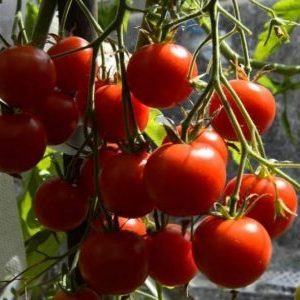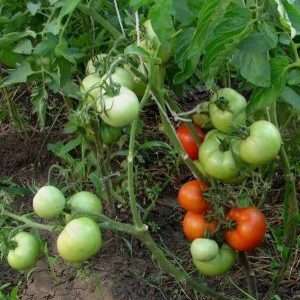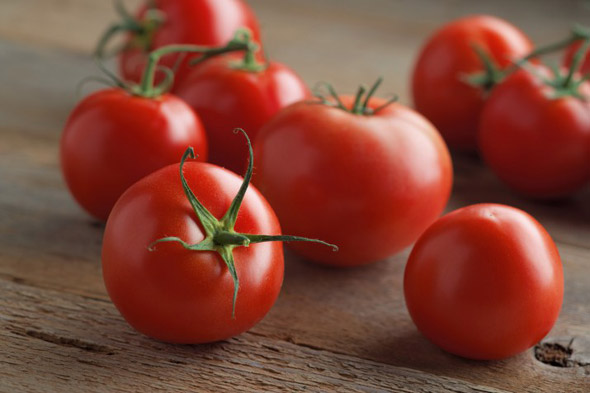A gift from the Ural breeders for regions with a cold climate - a tomato "Red Guard"
The Krasnaya Gvardiya tomato is a hybrid bred by Ural breeders in 2012. Excellent for growing in the northern regions of the Urals and Siberia, the middle zone and the Non-Black Earth Region. The uniqueness of this tomato lies in the combination of simple agricultural technology with the highest cold resistance.
The content of the article
Description of the hybrid Red Guard f1
Determinant early ripening variety. Suitable for both greenhouses and outdoor cultivation. The maximum bush can reach a height of 80cm and requires support.
The hybrid is resistant to lack of light and low temperatures. It matures successfully in a cool, short summer. Also has high resistance to basic diseases and pests.

Fruit characteristics and yield
Fruits are round, dense. The weight of each can reach 150-200 grams. At the stage of full maturity, the vegetable is deep red. The pulp is fleshy, with good taste. The fruits do not crack, have a small number of seed chambers, are distinguished by good keeping quality and are suitable for transportation.
The purpose of the fruit is universal. Subject to agricultural techniques, up to 3.5 kg of harvest can be harvested from one bush of the Red Guard tomato. One cluster usually has 7 to 9 fruits.
How to grow seedlings
It is recommended to sow planting material for seedlings 55-60 days before planting in a permanent place. For disinfection of seeds, one hour before sowing, they are placed in Fitosporin solution. If the purchased seeds have a bright coating, they do not need processing.
Capacity and soil
Seeds are planted in seedling boxes filled with soil, consisting of equal amounts of garden soil and compost. The container should not be deeper than 15 cm, and you can also use special purchased substrates for tomatoes.
Sowing
The seeds are laid in furrows to a depth of 1 cm and covered with earth. After that, the soil should be moistened with a little water.
Growing and care
To speed up the germination of seeds, the container with plantings must be kept in a room where the temperature does not drop below +25 degrees. In order for the development process to go smoothly, the seedlings are illuminated for 12 hours and irrigated periodically.
You need to dive seedlings at the stage of two true leaves.
If you plan to plant seedlings in open ground, then two weeks before moving to a permanent place, they begin to harden it. To do this, young bushes are taken out on the balcony for several hours, while it is necessary to ensure that the plants are not exposed to drafts.
How to grow tomatoes
The best precursors for tomato are legumes, cucumbers, cabbage, turnips and onions. The culture can be planted in the same place no earlier than three years later.
When moving seedlings into open ground under a film shelter, it is recommended to place 1 sq. no more than four plants, when transplanted into a greenhouse - no more than 2-3 bushes per square meter.
The quality of the soil should be taken care of in the fall, the upper part of the soil, about 10 cm, must be removed, since it may contain insect larvae and fungal spores. In the spring, the soil is dug up and compost is added.Young plants are transferred to prepared holes, 20-25 cm deep. This depth will guarantee a comfortable placement of the root system. Water immediately after planting.
Care
 Red Guard tomatoes need moderate weekly watering... If the weather is dry, it is necessary to moisten the planting every three days. Under each bush, you need to add at least 4 liters of water. The moisture content of the soil should be kept at a level of at least 85%. During the flowering period, watering should be increased, adding at least 5 liters of water under each bush.
Red Guard tomatoes need moderate weekly watering... If the weather is dry, it is necessary to moisten the planting every three days. Under each bush, you need to add at least 4 liters of water. The moisture content of the soil should be kept at a level of at least 85%. During the flowering period, watering should be increased, adding at least 5 liters of water under each bush.
After the fruits have formed, the plantings are watered twice a week. In this case, you cannot use a large amount of water so that the tomatoes do not crack. When the tomatoes start to turn red, the moisture application is reduced to once a week.
Weeding and loosening
The beds and aisles must be regularly rid of weeds so that the weeds do not draw off the beneficial elements vital for the tomato bushes.
The soil near the tomatoes should be loosened regularly to prevent crust formation. You can also a little mulch chopped straw soil. This will help to retain moisture and eliminate the need to loosen the soil.
Stealing and shaping
For the Krasnaya Gvardia variety, it is very important to carry out partial pinching, removing all shoots up to the first flower cluster, above it all stepchildren are left and it is on them that the main harvest is formed. If you ignore this procedure, the timing of the ripening of the crop will shift slightly.
The Red Guard tomato bush is compact enough and does not need to be formed.
Garter
Considering that the hybrid forms powerful clusters, the number of fruits on which can be more than seven, the garter is vital for the plant. To do this, a support is placed next to each bush and the twigs are alternately neatly tied to it from the bottom up.
Top dressing
Planting tomatoes are fed several times per season, alternating between different types of fertilizers.
The first application is carried out after two weeks. The tomato is fed with a urea solution. The main thing is to observe the dosage, since an excess of nitrogen negatively affects the formation of fruits.
A week after nitrogen feeding, you need to add a solution of potassium and phosphorus by watering. Mineral fertilizers can be replaced with ash, which is applied to the soil. Yeast can also be used for the second feed. This will help suppress the development of pathogens and promote the growth of beneficial bacteria.
During fruiting, tomatoes can be feed by spraying. To do this, prepare a solution of 10 liters of water and 1 tbsp. superphosphate. Spraying is carried out on the leaf.
Features of cultivation and possible difficulties
When planting in a permanent place of seedlings, it is important to remember that this hybrid is cold-resistant and it does not make the slightest sense to keep overgrown seedlings at home until warm weather.
You can not thicken the planting. Too often planted bushes will grow poorly, bloom poorly and lose ovaries.
When tying the stems, it is important not to apply too much pressure. Difficulties may arise with this, since the hands of the "Red Guard" are quite heavy. An improper garter can lead to the formation of constrictions, and sometimes to the death of the stem. To prevent this, when twisting it is necessary not to wrap the tomato stem around the twine, but the twine around the stem.
Diseases and pests
Tomato "Red Guard" is not damaged by cladosporiosis, fusarium and rootworm nematodes.
The only insect that can harm this crop is the whitefly. You can repel a pest attack using smoke or insecticidal preparations.
The nuances of growing in open ground and in a greenhouse

Tomato "Red Guard" requires good soil moisture, but the air must remain dry.When grown in a greenhouse, such conditions can be provided by ventilation.
It is not recommended to combine planting tomatoes and cucumbers in the same greenhouse. These equally popular crops require completely different growing conditions.
Watering tomato bushes in open ground, moisture should not be allowed to enter the leaves - this leads to sunburn. It is necessary to moisten the plantings strictly at the root.
Harvesting and application of the crop
Tomatoes reach technical ripeness by the end of July. Tomatoes have time to fully ripen even in the short northern summer.
The fruits of the Krasnaya Gvardia tomato can be eaten fresh, as well as used for the preparation of canned preparations, sauces, pasta or ketchup.
Advantages and disadvantages
There are no pronounced drawbacks in the Red Guard tomato, except that the need to organize support for the bushes during the growth process.
The advantages include:
- The fruits form and ripen quickly. This helps to avoid fungal infections, the disease simply does not have time to develop;
- High resistance to low temperatures, which allows you to get crops even in the polar regions;
- Unpretentiousness in terms of light and heat.
Farmers reviews

Olga, Chelyabinsk:I grew the "Red Guard" variety in a greenhouse. I am a novice gardener, so I did not know that there was such a procedure as pinching and, accordingly, did not carry it out. And the tomato bushes grew normally, did not get sick, they picked up the ovaries well and bore fruit. The taste of this variety is usual for a tomato, my family and I actively used the harvest for salads and pickling "
Nadezhda, Orenburg:“A very unpretentious variety. She removed her stepsons only up to the first hand, further growth went without any intervention. It began to ripen in the tenths of July. The harvest is good, the fruits are not cracked. I have also planted other varieties, which in my opinion are more suitable for fresh food, and Krasnaya Gvardiya ideally went for salting. "
Mikhailova Julia, Penza:“Unpretentious tomatoes. The only thing I had to tinker with was the garter. The fruits are heavy, there are many of them and they directly incline the whole bush to the ground. I had to tie each branch separately. But it was worth it. Tomatoes are dense, beautiful. "
Conclusion
Elementary agricultural technology, high resistance to cold and disease, as well as excellent yield make the Red Guard tomato an undeniable leader among other hybrids.
The versatility of the crop and its excellent taste have been deservedly appreciated by both experienced gardeners and those who have recently mastered the art of growing tomatoes.